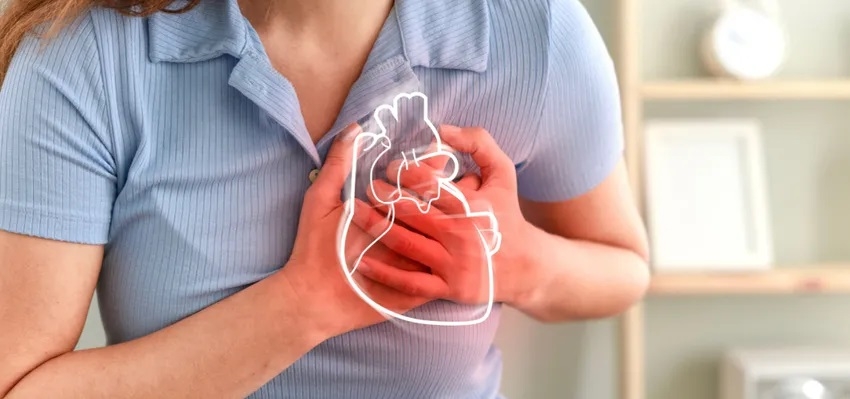Why Women Have Higher Risk Of Death After Cardiac Arrest Than Men
15 Feb 2025 16:55:58

Cardian arrest is one of the most
common causes of death worldwide, despite advances in modern medicine. What is
worse is that women are less likely to survive a cardiac arrest than men. A new
research done by researchers from the University Hospital Basel and the
University of Basel suggests, women are less likely to be admitted to an
intensive care unit after a cardiac arrest. They receive less intensive care
treatment and have a higher risk of dying than men.
Data indicate that women often have
less chances of survival after a cardiac arrest and lower quality of life than
men. The reasons for this are manifold and, in addition to biological
differences, could also be attributed to less frequent or delayed resuscitation
measures in women. Research concludes that gender-specific differences in the
intensity of treatment before and after admission to the intensive care unit
and in the decision on life-prolonging measures are also considered to be the
cause of unequal chances of survival. However, there is hardly any research
data on these gender-specific differences.
Here are some of the reasons that
could make women's survival difficult after a cardiac arrest than men.
Delay in recognition and treatment
Compared to men, women experience
different heart attack symptoms. For men, it is chest pain, which primary
symptom of heart attach. However, women might feel nausea, fatigue, shortness
of breath, or jaw or back pain, which can delay the diagnosis.
Studies show that bystanders are
less likely to perform CPR on women possibly due to hesitation or fear of
causing harm.
Unlike men, women are less likely to
receive immediate and timely interventions like angioplasty.
Difference in heart anatomy and
physiology
Women's hearts are generally
smaller, with narrower arteries compared to men, which can complicate treatment
Hormonal differences, especially
post-menopause, increase the risk of arrhythmias and decrease blood vessel
flexibility, leading to higher chances of complications after cardiac arrest.
Coexisting conditions
In most cases, women who suffer
cardiac arrest have underlying health issues such as hypertension, diabetes, or
kidney disease, which can worsen the outcomes of the treatment.
HFpEF, Heart faliure with preserved
ejection fraction is more common in women. This condition is harder to treat
effectively compared to heart failure with reduced ejection fraction.
Post-cardiac arrest care
The study suggests women are less
likely to receive aggressive treatments like therapeutic hypothermia (a cooking
technique to improve outcome after cardiac arrest) or cardiac catheterisation.
Although, there are no enough
studies that prove that there are biases in healthcare when it comes to
treating women after a cardiac arrest, the study does touch upon the data that
implicit biases may lead to differences in how women are evaluated and treated
compared to men.
Physiological factors
Women re more likely to live alone
or be primary caregivers, which can impact their ability to recover after
cardiac arrest.
Mental health issues, such as
anxiety and depression are common in women, which can negatively affect the
outcomes and recovery and at the first place, can be a cause of heart attack or
cardiac arrest.
Hormonal impact
After menopause, estrogen's
protective effect decline in women, which increase the risk of cardiovascular
events and complications.
Younger women, on the other hand,
have more chances of survival due to estrogen. With age this advantage fades,
which puts postmenopausal women at a higher risk of cardiac arrest or heart
attack.
How to prevent cardiac arrest
Here are some prevention tips to
reduce the risk of cardiac arrest or cardiovascular diseases to improve heart
health for women.
Don't ignore the warning signs
In most women, heart attach symptoms
can be subtle. Chest discomfort, shortness of breath, unexplained fatigue or
weakness, nausea or vomiting, pain the back, jaw, neck, or arms. If you feel
these symptoms and something off, seek medical help.
Stay physically active
Regular exercise makes your heart
strong and improves blood flow in the body. At least 150 minutes of
moderate-intensity activity per week is advisable. Brisk walking, and swimming
are best. At least two sessions of strength training per week are recommended.
Small changes like taking the stairs
or going for a walk, can make a difference.
Maintain heart healthy diet
Focus more on a diet that support
your heart and cardiovascular health.
Eat more fruits and vegetables,
whole grains, healthy fats like olive oil, nuts, avocados, fatty fish, lead
protein.
Limit consumption of processed food,
sugar and refined carbs, trans fats and saturated fats, and excessive salt.
Monitor blood pressure and
cholesterol
High blood pressure and high
cholesterol are major risk factors for heart and cardiac disease, including
arrest. It is advisable to go for regular check-ups and if your number are
high, work with your doctor on lifestyle changes or modifications to bring them
down.
Manage stress
Chronic stress, anxiety, and
depression can increase the risk of heart issues. Practice, yoga, meditation
and mindfulness. Do deep breathing exercises and priorities self-care.
Remember, nothing is more important than happy mind and body.
Avoid smoking and alcohol
Smoking is a worst thing for your
heart, lungs, and every part of your body. Quitting cigarette reduces the risk
of heart issues. When it comes to alcohol, it is advisable to consume it in
limit. One drink in a day for women is considered safe.
Get enough sleep
If you are not sleeping enough, it
can lead to heart related issues. It is now a known and proven fact that 7-8
hours of quality sleep per night is essential for humans to function well. If
you are facing sleep issues like insomnia, sleep apnea, it is advisable to
address them on priority as they can put you at a risk of heart issues.